
Science with Passion
Application No.: VFD0188 Version 1 12/2020
No blood(y) stress –Phenolic antioxidants in olive oil and olive oil wastewater
Juliane Böttcher, Kate Monks; applications@knauer.net
KNAUER Wissenschaftliche Geräte GmbH, Hegauer Weg 38, 14163 Berlin
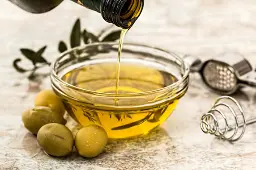
Foto: pexels-pixabay
Summary
The content of polyphenols, or biophenols, in olive oil is interesting due to their attributed benefits and impact on human health. Only with a certain amount of biophenols the manufacturer can advertise the product to have a positive effect on health [1]. But also, the wastewater incurring in olive oil production can still contain the coveted polyphenols. These wastewaters, which are mostly discarded, might be a source for a possible recovery of these biologically interesting constituents [2].
Introduction
Polyphenols are secondary plant compounds that can offer various health benefits. They can act as antioxidants or be helpful due to their anti-inflammatory effects, for example. There are many foods, plants and vegetables which are rich in polyphenols but in this application the focus was set on olive oil and wastewater from olive oil production. With Commission Regulation (EU) No 432/2012 of 16 May 2012 a list of permitted health claims made on food was established3. Referring to this list, olive oils can be labeled with the addition “Olive oil polyphenols contribute to the protection of blood lipids from oxidative stress”. The claim may be used only for olive oil which contains at least 5 mg of hydroxytyrosol and its derivatives (e.g. oleuropein complex and tyrosol) per 20 g of olive oil. In order to bear the claim information shall be given to the consumer that the beneficial effect is obtained with a daily intake of 20 g of olive oil [3]. The profile of biophenolic compounds in olive oils and its wastewater is quite complex with far over 20 possible substances. A detailed method for profiling olive oil samples is provided by the International Olive Council4. Most of the used standards described in that method are commercially unavailable, thus in the following application the determination of only eight compounds (3-hydroxytyrosol, tyrosol, 4-hydroxyphenylacetic acid, vanillic acid, caffeic acid, syringic acid, oleuropein, and quercetin) was conducted with an adapted method.
Results
For peak identification, single standards of the eight phenolic compounds were measured. Thereafter a mixed standard stock solution was prepared. For calibration, the stock solution was diluted to five different levels (Tab. 1).

Fig. 1 Chromatogram of mixed standard at calibration level 5.
1 - 3-hydroxytyrosol, 2 - Tyrosol, 3 - 4-hydroxyphenylacetic acid, 4 - Vanillic acid, 5 - Caffeic acid, 6 - Syringic acid, 7 - Oleuropein, 8 - Quercetin.
Tab. 1 Concentrations of calibration levels
Substance | Level 1 | Level 2 (µg/ml) | Level 3 (µg/ml) | Level 4 (µg/ml) | Level 5 (µg/ml) |
3-Hydroxyty-rosol | 4.400 | 6.600 | 13.200 | 66.000 | 132.000 |
Tyrosol | 1.233 | 1.850 | 3.700 | 18.500 | 37.000 |
4-Hydroxyphenylacetic acid | 1.967 | 2.950 | 5.900 | 29.500 | 59.000 |
Vanillic acid | 0.867 | 1.300 | 2.600 | 13.000 | 26.000 |
Caffeic acid | 1.367 | 2.050 | 4.100 | 20.500 | 41.000 |
Syringic acid | 0.867 | 1.300 | 2.600 | 13.000 | 26.000 |
Oleuropein | 1.967 | 2.950 | 5.900 | 29.500 | 59.000 |
Quercetin | 0.733 | 1.100 | 2.200 | 11.000 | 22.000 |
The calibration was successful with a linearity of R2 ≥ 0.9996 for all compounds. Based on the calibration measurements the limit of detection (LOD) and limit of quantification (LOQ) were calculated (Tab. 2). For LOD a signal-to-noise ratio (S/N) of S/N=3 was taken as basis of calculation and for LOQ a ratio of S/N=10 was specified.
Tab. 2 Calculated LOD and LOQ
Substance | LOD S/N=3 (µg/ml) | LOQ S/N=10 (µg/ml) |
3-Hydroxytyrosol | 0.794 | 2.645 |
Tyrosol | 1.316 | 4.386 |
4-Hydroxyphenylacetic acid | 1.944 | 6.481 |
Vanillic acid | 0.641 | 2.138 |
Caffeic acid | 0.382 | 1.274 |
Syringic acid | 0.463 | 1.543 |
Oleuropein | 1.963 | 6.542 |
Quercetin | 0.431 | 1.437 |
Five commercially available olive oils were tested and prepared according to the Internal Olive Council sample preparation method (section 5.1) [4] with the changes mentioned in the sample preparation section. All samples were marked as “native extra” but none of the samples was labelled according to Health Claims Regulation. Exemplarily two chromatograms of olive oil samples are shown. Three of the calibrated substances were detected in the sample (Fig. 2). Except for 3-hydroxytyrosol the calculated amounts were below the LOQ of the method.
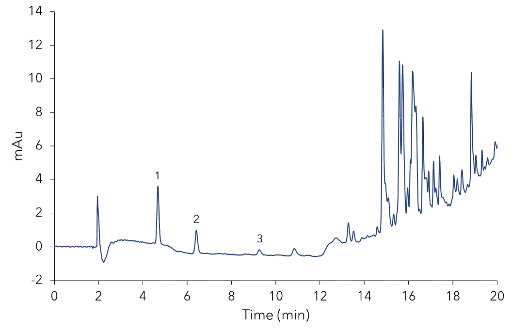
Fig. 2 Chromatogram of olive oil sample 2. 1 - 3-hydroxytyrosol, 2 - Tyrosol, 3 - vanillic acid.
Results

Fig. 3 Amounts of phenols in samples in mg/20g.
In the second sample also some of the calibrated compounds were detected. Again except for 3-hydroxytyrosol the amounts were below the calculated limit of quantification or even limit of detection. The detectable substances were quantified (Tab. 3, Fig. 5). Caffeic acid and 4-hydroxyphenylacetic acid were neither found in olive oil nor in wastewater samples.
Tab. 3 Results of sample measurement, *= below LOQ/LOD
Substance | Sample 1 (µg/ml) | Sample 2 (µg/ml) | Sample 3 (µg/ml) | Sample 4 (µg/ml) | Sample 5 (µg/ml) |
3-Hydroxyty- rosol | 4.107 | 3.641 | 6.375 | 3.433 | 4.289 |
Tyrosol | 2.620* | 2.594* | 4.107* | 2.813* | 3.352* |
Vanillic acid | - | 0.393* | - | - | - |
Syringic acid | 0.322* | - | 0.386* | - | 0.207* |
Oleuropein | 1.375* | - | - | - | 1.859* |
Quercetin | 1.131* | - | - | 1.430* | 1.623 |
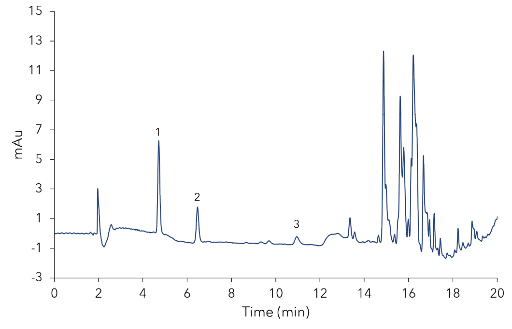
Fig. 4 Chromatogram of olive oil sample 3. 1 - 3-hydroxytyrosol, 2 - Tyrosol, 3 - Syringic acid.
Tyrosol and 3-hydroxytyrosol were found in each of the five samples whereas the other calibrated compounds show different composition patterns. Instead of using an internal standard, the recovery rate was determined. Therefore, one of the samples was spiked with the mixed standard at different concentrations and extracted according to sample preparation procedure.
Tab. 4 Recovery rate for extraction procedure
Substance | Recovery rate (%) |
3-Hydroxytyrosol | 99.77 |
Tyrosol | 92.28 |
4-Hydroxyphenylacetic acid | 88.86 |
Vanillic acid | 98.96 |
Caffeic acid | 92.20 |
Syringic acid | 90.25 |
Oleuropein | 52.93 |
Quercetin | 73.77 |
Furthermore, two wastewater samples from an olive oil production process were measured. The target was to verify if the wastewater still contains amounts of polyphenols which could be of interest for recovery and/or re-use. Recovery rates for the wastewater samples were not determined.
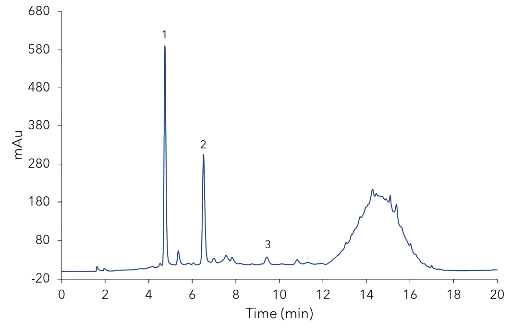
Fig. 5 Chromatogram of olive oil wastewater sample 1. 1 - 3-hydroxytyrosol, 2 - Tyrosol, 3 - Vanillic acid.

Fig. 6 Chromatogram of olive oil wastewater sample 2. 1 - 3-hydroxytyrosol, 2 - Tyrosol, 3 - Oleuropein.
Both wastewater samples contain high residues of 3-hydroxytyrosol and tyrosol as well as small amounts of other of the calibrated substances (Tab. 5).
Tab. 5 Recovery rate for extraction procedure
Substance | Wastewater 1 (µg/ml) | Wastewater 2 (µg/ml) |
3-Hydroxytyrosol | 537.336 | 179.115 |
Tyrosol | 484.373 | 413.389 |
4-Hydroxyphenylacetic acid | - | - |
Vanillic acid | 16.258 | - |
Caffeic acid | - | - |
Syringic acid | - | - |
Oleuropein | - | 48.740 |
Quercetin | - | - |
The application was realized with the kind support of the FiW - Research Institute for Water and Waste Management at RWTH Aachen e. V. and the Institute for Applied Polymer Chemistry (IAP) of FH Aachen. The work was carried out within the CLIENT II research project „I-WALAMAR“ (FKZ: 01LZ1807C).
Sample Preparations
Single standards were dissolved in methanol. Out of these single standards a mixed standard was prepared. Olive oil samples were prepared according to International Olive Council method (section 5.1 Sample preparation) [4], but without the use of an internal standard. Furthermore, the 0.45 µm PVDF (polyvinylidene fluoride) filter was replaced by a 0.45 µm RC (regenerated cellulose) filter. Wastewater samples were prepared with manual solid phase extraction using CHROMABOND C18, 45 µm, 3 ml/500 mg SPE columns5. The applied SPE method was taken from the Macherey Nagel application database [6].

Fig. 7 SPE method parameters
Conclusion
Although the measured olive oil samples were not labelled with the claim “Olive oil polyphenols contribute to the protection of blood lipids from oxidative stress” [3], the samples would meet the requirements. For all extracts an amount of at least 5 mg of 3-hydroxytyrosol and its derivatives (e.g. oleuropein complex and tyrosol) per 20 g of olive oil were determined (Tab. 3, Fig. 4). The analyzed wastewater samples showed high amounts of 3-hydroxytyrosol and tyrosol (Tab. 5). With an appropriate sample preparation and possibly preparative HPLC purification, it should be feasible to recover these substances and make them usable for other areas of application.
References
[1] Olea. https://www.oelea.de/olivenoel-analyse-polyphenole (2020/05/11).
[2] Mulinacci, N. et al. Polyphenolic content in olive oil waste waters and related olive samples. Journal of Agricultural and Food Chemistry 49(8):3509-14 (2001).
[3] Official journal of the european union. Commission regulation (EU) No 432/2012. https://eur-lex.europa.eu/legal-content/EN/TXT/PDF/?uri=CELEX:32012R0432&from=EN (2020/06/11).
[4] International olive council. Determination of biophenols in olive oils by HPLC. https://www.internationaloliveoil.org/wp-content/uploads/2019/11/COI-T.20-Doc.-No-29-Rev-1-2017.pdf (2020/06/11).
[5] Macherey-Nagel. Solid phase extraction. https://www.mn-net.com/de/spe-columns-chromabond-c18-45-m-3-ml/500-mg-730003?c=4514 (2020/06/11).
[6] Macherey-Nagel. Determination of twenty phenolic compounds from Alperujo (A semisolid waste from the olive oil industry). https://chromaappdb.mn-net.com/SPE/9D0DD88B-3C0E-27CA-7712-C260CB3F95EC/determination-of-twenty-phenolic-compounds-from-alperujo-a-semisolid-waste-from-the-olive-oil-industry (2020/06/11).
Materials and Methods
Tab. 6 Method settings
Column temperature | 30 °C |
Injection volume | 10 µl |
Injection mode | Partial loop |
Detection | UV 280 nm |
Data rate | 20 Hz |
Time constant | 0.05 s |
Tab. 7 Pump parameters
Eluent (A) | 0.2% phosphoric acid
| ||
Eluent (B) | methanol | ||
Flow rate | 1.2 ml/min | ||
Gradient | Time (min) | % A | % B |
0 | 90 | 10 | |
3 | 80 | 20 | |
10 | 75 | 25 | |
18 | 0 | 100 | |
20 | 0 | 100 | |
20.02 | 90 | 10 | |
23 | 90 | 10 |
Tab. 8 System configuration
Instrument | Description | Article No. |
Pump 1 | AZURA P6.1L HPG, 10 ml | |
Autosampler | AZURA AS 6.1L | |
Detector | AZURA DAD 6.1L | |
Flow cell | Analytical KNAUER pressureproof UV flow cell cartridge | |
Thermostat | AZURA CT 2.1 | |
Column | Eurospher II 100-5 C18A, 250 x 4 mm ID with precolumn | |
Software | ClarityChrom 8.2.3 – Workstation, autosampler control included | |
Software | ClarityChrom 8.2.3 – PDA extension |
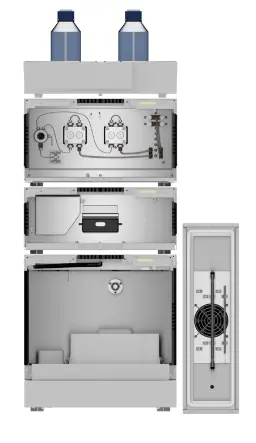
Application details
|
Method |
HPLC |
|
Mode |
RP |
|
Substances |
3-Hydroxytyrosol, Tyrosol, 4-Hydroxyphenylacetic acid, Vanillic acid, Caffeic acid, Syringic acid, Oleuropein, Quercetin |
|
CAS number |
10597-60-1, 331-39-5, 32619-42-4, 156-38-7, 501-94-0, 117-39-5, 530-57-4, 121-34-6 |
|
Version |
Application No.: VFD0188 | Version 1 12/2020 | ©KNAUER Wissenschaftliche Geräte GmbH |


